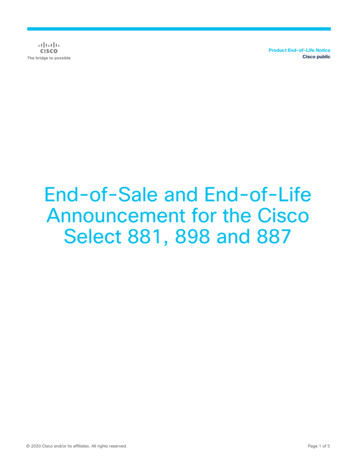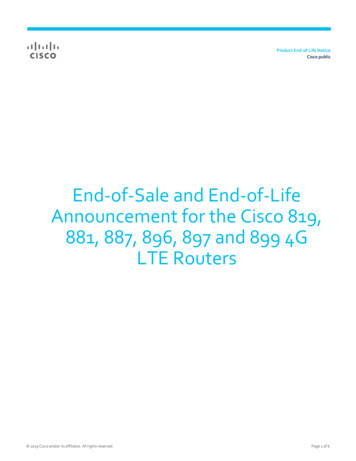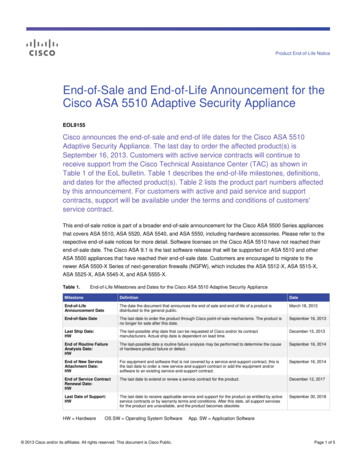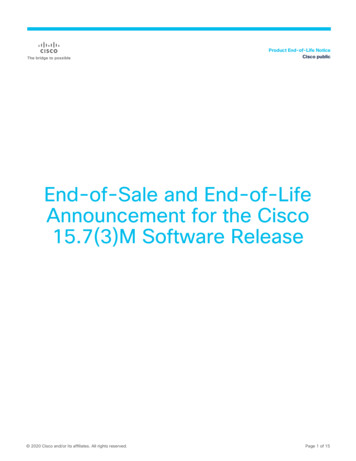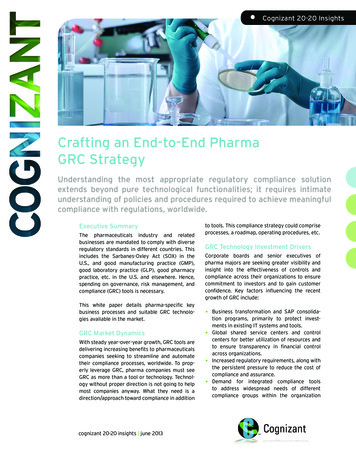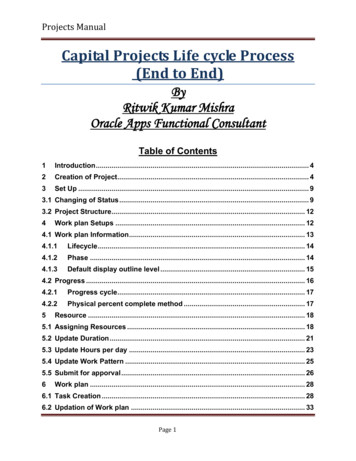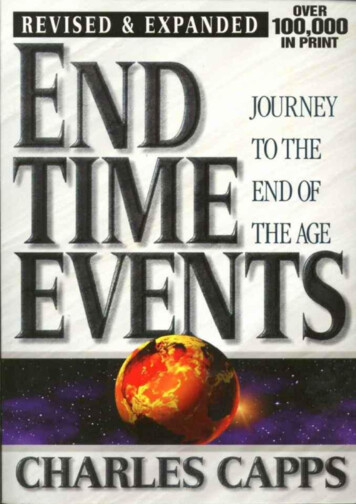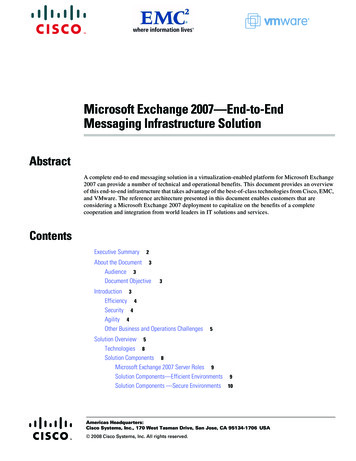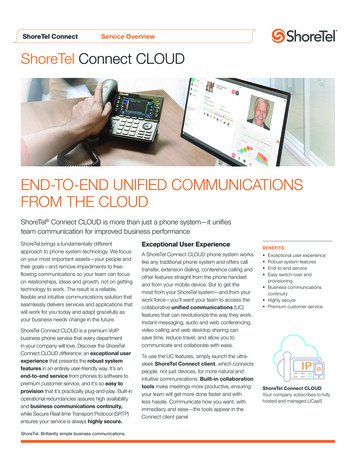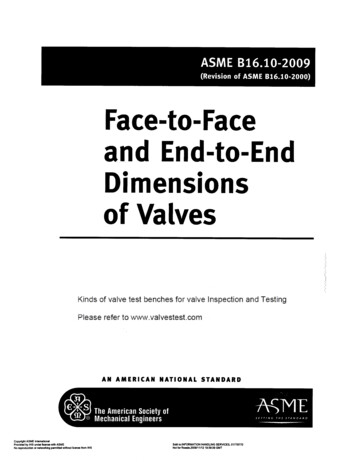
Transcription
ASME B16.10-2009(Revision of ASME B16.10-2000)Face-to-Faceand End-to-EndDimensionsof ValvesAN AMERICAN NATIONAL STANDARDCopyright ASME InternationalProvided by IHS under license with ASMENo reproduction or networking permitted without license from IHSSold to:INFORMATION HANDLING SERVICES, 01779770Not for Resahs,2009/11/12 19:39:39 GMT
Date of Issuance: October 28, 2009The next edition of this Standard is scheduled for publication in 2014. There will be no addendaissued to this edition.ASME issues written replies to inquiries concerning interpretations of technical aspects of thisStandard. Interpretations and errata are published on the ASME Web site under the Committee Pagesat http://cstools.asme.org as they are issued.ASME is the registered trademark of The American Society of Mechanical Engineers.This code or standard was developed under procedures accredited as meeting the criteria for American NationalStandards. The Standards Committee that approved the code or standard was balanced to assure that individuals fromcompetent and concerned interests have had an opportunity to participate. The proposed code or standard was madeavailable for public review and comment that provides an opportunity for additional public input from industry, academia,regulatory agencies, and the public-at-large.ASME does not "approve," "rate," or "endorse" any item, construction, proprietary device, or activity.ASME does not take any position with respect to the validity of any patent rights asserted in connection with anyitems mentioned in this document, and does not undertake to insure anyone utilizing a standard against liability forinfringement of any applicable letters patent, nor assume any such liability. Users of a code or standard are expresslyadvised that determination of the validity of any such patent rights, and the risk of infringement of such rights, isentirely their own responsibility.Participation by federal agency representative(s) or person(s) affiliated with industry is not to be interpreted asgovernment or industry endorsement of this code or standard.ASME accepts responsibility for only those interpretations of this document issued in accordance with the establishedASME procedures and policies, which precludes the issuance of interpretations by individuals.No part of this document may be reproduced in any form,in an electronic retrieval system or otherwise,without the prior written permission of the publisher.The American Society of Mechanical EngineersThree Park Avenue, New York, NY 10016-5990Copyright 2009 byTHE AMERICAN SOCIETY OF MECHANICAL ENGINEERSAll Rights ReservedPrinted in U.S.A.Copyright ASME InternationalProvided by IHS under license with ASMENo reproduction or networking permitted without license from IHSSold to:INFORMATION HANDLING SERVICES, 01779770Not for Resale,2009111/12 19:39:39 GMT
CONTENTSForewordCommittee RosterCorrespondence With the B16 Committeeivvi1Scope12Definitions23Facings of Flanged Valves34Variations of Length Within a Class of Valves35Tolerances4Figures1Flange Facings and Their Relationships2 Welding Ends56Tables12345678910Class 125 Cast Iron Flanged and Class 150 Steel Flanged and Buttwelding EndValves, Face-to-Face and End-to-End DimensionsClass 250 Cast Iron Flanged and Class 300 Steel Flanged and Buttwelding EndValves, Face-to-Face and End-to-End DimensionsClass 600 Steel Flanged and Buttwelding End Valves, Face-to-Face and End-to-EndDimensionsClass 900 Steel Flanged and Buttwelding End Valves, Face-to-Face and End-to-EndDimensionsClass 1500 Steel Flanged and Buttwelding End Valves, Face-to-Face and End-toEnd DimensionsClass 2500 Steel Flanged and Buttwelding End Valves, Face-to-Face and End-toEnd DimensionsClasses 125 and 250 Cast Iron and Classes 150 to 2500 Steel Wafer Type Valves,Face-to-Face DimensionsClasses 25 and 125 Cast Iron and Classes 150 to 600 Steel Butterfly Valves,Face-to-Face DimensionsDetermination of Face-to-Face and End-to-End Dimensions of Flanged ValvesHaving Various Flange FacingsClasses 150 to 2500 Steel Valves Having End Flanges With Ring Joint Facings,End-to-End Dimensions7101315161819202122Mandatory AppendixIFace-to-Face and End-to-End Dimensions: U.S. Customary Units25Nonmandatory AppendixAReferences42iiiCopyright ASME InternationalProvided by IHS under license with ASMENo reproduction or networking permitted without license from IHSSold to:INFORMATION HANDLING SERVICES, 01779770Not for Resale,2009/11112 19:39:39 GMT
FOREWORDIn 1921, the American Engineering Standards Committee, later the American StandardsAssociation (ASA), organized Sectional Committee B16 to unify and further develop nationalstandards for pipe flanges and fittings (and, later, for valves, gaskets, and valve actuators).Cosponsors of the B16 Committee were The American Society of Mechanical Engineers (ASME),the Heating and Piping Contractors National Association [now the Mechanical ContractorsAssociation of America (MCAA)], and the Manufacturers Standardization Society of the Valveand Fittings Industry (MSS). Cosponsors were later designated as cosecretariat organizations.Pioneer work on standardization of end-to-end dimensions of valves began in 1917 under thedirection of J. A. Stevens. It was put aside at the end of World War I and interest did not reviveuntil 1926. ASA and ASME agreed to include the topic in the scope of the B16 Committee, andSubcommittee 5 (now Subcommittee E) was established for the purpose. Work began in 1928and covered ferrous flanged-end gate, globe, angle, and check valves.Development of a national standard was hindered by the diversity of existing practices andby adverse economic conditions in the early 1930s. A proposed 1933 American Standard for faceto-face dimensions of ferrous flanged valves did not gain acceptance, even though it was largelybased on a 1931 Standard Practice of MSS. Further work and industry developments led to ameeting in May 1937, which undertook to reconcile differences among the draft ASA standard,two American Petroleum Institute (API) standards (5-G-1 on pipeline valves and 600A on flangedOS&Y steel wedge gate valves), and a newly updated MSS SP-32.A revised B16 proposal was voted favorably in June 1938, was approved by ASA, and waspublished in 1939. The standard was reaffirmed in 1947. Work began on a revision in 1953 toinclude buttwelding end valves, plug valves, and control valves in both cast iron and steel.That edition was published as ASA B16.10-1957. Further revision was begun in 1964. Afterreorganization of ASA, first as the United States of America Standards Institute (USASI), thenas American National Standards Institute (ANSI), with the Sectional Committee being redesignated as an American National Standards Committee, a new edition adding ball valves wasapproved and published as ANSI B16.10-1973.In 1982, American National Standards Committee B16 was reorganized as an ASME Committeeoperating under procedures accredited by ANSI. In the 1986 Edition, ductile iron and the alloyscovered by ANSI B16.34 were added to the materials covered. Wafer type gate and check valves,Class 150 Y-pattern globe and check valves, and several patterns of butterfly valves were added tothe types covered. Inch dimensions were converted from common to two-place decimal fractions.In 1991, Subcommittee E — Face-to-Face and End-to-End Dimensions of Valves, was combinedwith Subcommittee N — Steel Valves. In the 1992 Edition, steel offset seat and grooved endbutterfly valves were added. Globe and flangeless style control valves, which previously hadbeen included, were removed from the Standard. Information regarding control valve dimensionsmay be obtained from Instrument Society of America, 67 Alexandria Drive, Research TrianglePark, NC 27709.In the 2000 Edition, metric dimension tables were added. All tables and references to Class400 steel and Class 800 cast iron were removed. All tables were renumbered. Following theapprovals of the Standards Committee and ASME, approval for the new edition was granted bythe American National Standards Institute on June 7, 2000.In this 2009 Edition, Nonmandatory Appendix A was revised and updated. Also, all affectedregions of this Standard were updated to reflect the changes in Nonmandatory Appendix A. PNvalues and references to API 605 have been removed from the Standard.Following approval by the B16 Standards Committee and the ASME Supervisory Board, thisStandard was approved as an American National Standard by ANSI on June 15, 2009.ivCopyright ASME InternationalProvided by IHS under license with ASMENo reproduction or networking permitted without license from IHSSold to:INFORMATION HANDLING SERVICES, 01779770Not for Resele,2009/11/12 19:39:39 GMT
ASME B16 COMMITTEEStandardization of Valves, Flanges,Fittings, and Gaskets(The following is the roster of the Committee at the time of approval of this Standard.)STANDARDS COMMITTEE OFFICERSW. B. Bedesem, ChairM. L. Nayyar, Vice ChairD. R. Sharp, SecretarySTANDARDS COMMITTEE PERSONNELG. A. Jolly, Vogt Valves/FlowserveM. Katcher, Haynes InternationalW. N. McLean, B&L EngineeringT. A. McMahon, Fisher Controls International, Inc.M. L Nayyar, Bechtel Power Corp.J. D. Page, U.S. Nuclear Regulatory CommissionW. H. Patrick, The Dow Chemical Co.R. A. Schmidt, Hackney Ladish, Inc.D. R. Sharp, The American Society of Mechanical EngineersH. R. Sonderegger, Anvil International, Inc.W. M. Stephan, Flexitallic LPD. A. Williams, Southern Company ServicesR. W. Barnes, ANRIC Enterprises, Inc.W. B. Bedesem, ExxonMobil Research & Engineering Co.D. F. Buccicone, Elkhart Products Corp.A. M. Cheta, Shell Westhollow Technology CenterM. Clark, NIBCO, Inc.G. A. Cuccio, Capital Manufacturing Co.C. E. Davila, Crane ValvesC. E. Floren, Mueller Co.D. R. Frikken, Becht Engineering Co.R. P. Griffiths, U.S. Coast GuardM. L. Henderson, TIEC, Inc.SUBCOMMITTEE N — STEEL VALVESW. N. McLean, Chair, B&L EngineeringT. A. McMahon, Vice Chair, Fisher Controls International, Inc.A. P. Maslowski, Secretary, The American Society of MechanicalEngineersR. W. Barnes, ANRIC Enterprises, Inc.W. B. Bedesem, ExxonMobil Research & Engineering Co.R. A. Benjamin, Northrop Grumman Corp.T. R. Brooks, ConsultantC. E. Davila, Crane ValvesD. R. Frikken, Becht Engineering Co.C. L Henley, Black & VeatchG. A. Jolly, Vogt Valves/FlowserveM. Katcher, Haynes InternationalM. L Nayyar, Bechtel Power Corp.J. D. Page, U.S. Nuclear Regulatory CommissionJ. Paptzun, ConsultantW. H. Patrick, The Dow Chemical Co.D. W. Rahoi, CCM 2000R. W. Rapp, ConsultantH. R. Sonderegger, Anvil International, Inc.J. R Tucker, FlowserveJ. T. White, PSNSY & IMFM. M. Zaidi, JacobsVCopyright ASME InternationalProvided by IHS under license with ASMENo reproduction or networking permitted without license from IHSSold to:INFORMATION HANDLING SERVICES, 01779770Not for Resele,2009/11112 19:39:39 GMT
CORRESPONDENCE WITH THE 616 COMMITTEEGeneral. ASME Standards are developed and maintained with the intent to represent theconsensus of concerned interests. As such, users of this Standard may interact with the Committeeby requesting interpretations, proposing revisions, and attending Committee meetings. Correspondence should be addressed to:Secretary, B16 Standards CommitteeThe American Society of Mechanical EngineersThree Park AvenueNew York, NY 10016-5990As an alternative, inquiries may be submitted via e-mail to: SecretaryB16@asme.org .Proposing Revisions. Revisions are made periodically to the Standard to incorporate changesthat appear necessary or desirable, as demonstrated by the experience gained from the applicationof the Standard. Approved revisions will be published periodically.The Committee welcomes proposals for revisions to this Standard. Such proposals should beas specific as possible, citing the paragraph number(s), the proposed wording, and a detaileddescription of the reasons for the proposal, including any pertinent documentation.Interpretations. Upon request, the B16 Committee will render an interpretation of any requirement of the Standard. Interpretations can only be rendered in response to a written request sentto the Secretary of the B16 Standards Committee.The request for interpretation should be clear and unambiguous. It is further recommendedthat the inquirer submit his/her request in the following format:Subject:Edition:Question:Cite the applicable paragraph number(s) and the topic of the inquiry.Cite the applicable edition of the Standard for which the interpretation isbeing requested.Phrase the question as a request for an interpretation of a specific requirementsuitable for general understanding and use, not as a request for an approvalof a proprietary design or situation. The inquirer may also include any plansor drawings that are necessary to explain the question; however, they shouldnot contain proprietary names or information.Requests that are not in this format will be rewritten in this format by the Committee priorto being answered, which may inadvertently change the intent of the original request.ASME procedures provide for reconsideration of any interpretation when or if additionalinformation that might affect an interpretation is available. Further, persons aggrieved by aninterpretation may appeal to the cognizant ASME Committee or Subcommittee. ASME does not"approve," "certify," "rate," or "endorse" any item, construction, proprietary device, or activity.Attending Committee Meetings. The B16 Standards Committee regularly holds meetings, whichare open to the public. Persons wishing to attend any meeting should contact the Secretary ofthe B16 Standards Committee.viCopyright ASME InternationalProvided by INS under license with ASMENo reproduction or networking permitted without license from IHSSold to:INFORMATION HANDLING SERVICES, 01779770Not for Rasa10,2009/11/12 19:39:39 GMT
ASME B16.10-2009FACE-TO-FACE AND END-TO-ENDDIMENSIONS OF VALVES1 SCOPE1.3 Cast Iron Valves1.1 GeneralOnly flanged end valves (and others intended
In 1982, American National Standards Committee B16 was reorganized as an ASME Committee operating under procedures accredited by ANSI. In the 1986 Edition, ductile iron and the alloys covered by ANSI B16.34 were added to the materials covered. Wafer type gate and check valves, Class 150 Y-pattern globe and check valves, and several patterns of butterfly valves were added to the types

